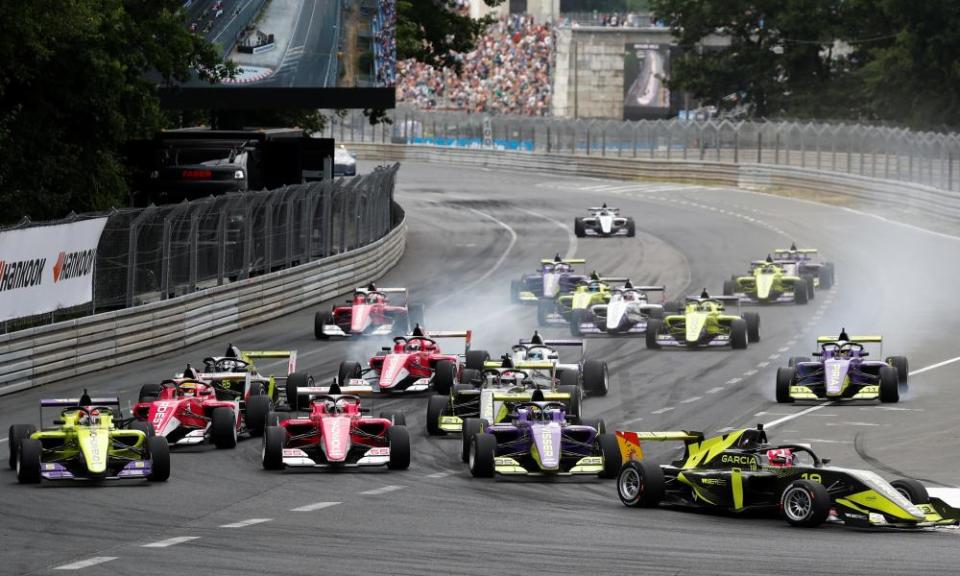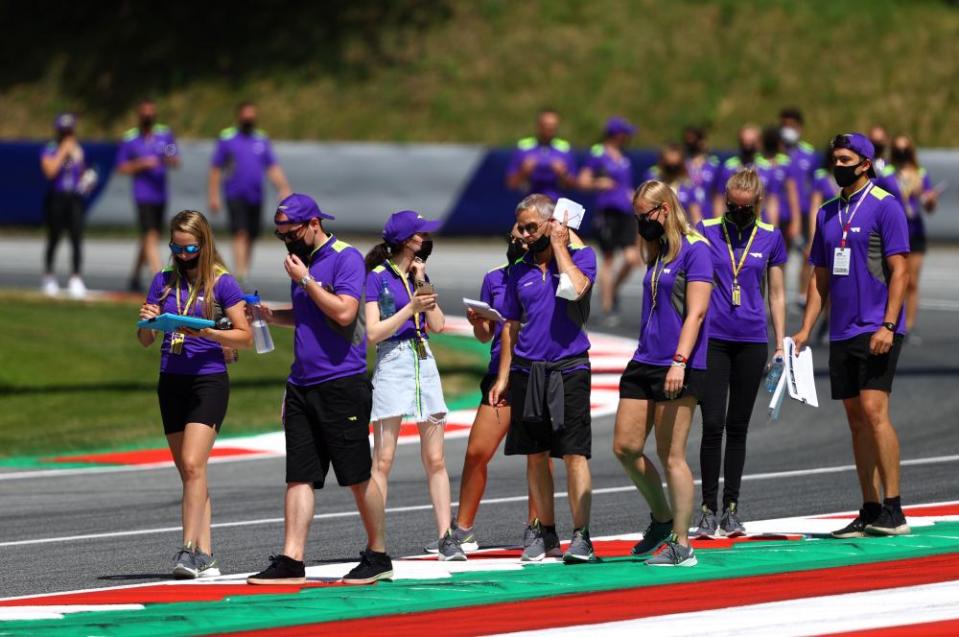‘We created a bit of magic’: W Series gets back on track on grand new stage

When the champagne flowed for the drivers at the finale of the inaugural W Series season in 2019 the championship itself was, appropriately, positively fizzing at its own success.
That first season was revelatory. After six races concluded with a finale at Brands Hatch where Britain’s Jamie Chadwick took the title, it had provoked huge interest and made a genuine difference to the competitors, proving the principles on which the all-female championship was founded were sound.
Related: W Series returns with innovative team structure and alongside Formula One
And then came the pandemic, cancelling the entire 2020 season and at one point leaving the series’ chief executive, Catherine Bond Muir, concerned for its future.
But the W Series makes its return on Saturday in Austria all the more significant. All eight races will take place on the grandest stage, as support races to Formula One. Its new status is appropriate. The series, which involves single-seater, F3 cars and meets all the costs of the participants, was created to give opportunities to and promote women in motorsport – drivers and engineers. Its ultimate goal is to help propel a woman into F1, which has not had a female driver compete at a grand prix since Lella Lombardi raced in Austria in 1976.
After her success in the opening season, Chadwick was taken on by the Williams F1 team as a development driver, a role she maintains. Liechtenstein’s Fabienne Wohlwend became a household name in her home country with backing to race full-time, while the hugely talented Marta García, whose career had stalled owing to lack of funding, has seen her profile rocket in Spain. Britain’s Alice Powell, who all but believed her racing days were over, found a series of new drives opening up after she was given the chance to once more show off her skills on track.
What began trackside in Hockenheim in May 2019 with intrigued onlookers ended with a groundswell of girls, women and families swarming the paddock at Brands. Speaking before the first race of the season here in Austria on Saturday, Bond Muir, for whom creating the championship was a passion project that begun in 2015, describes what was an emotional moment. “We created a bit of magic there,” she says. “We had huge numbers fully engaged with us, looking at our drivers as though they were superstars, a huge amount of love and support. W Series isn’t just about getting women on to the grid but about women being more visible in all parts of motorsport.”

Chadwick echoes Bond Muir’s belief in the importance of the championship. “There is still a long way to go in terms of the perception of women in motorsport,” she explains. “A lot of people still seem surprised that women actually compete in motorsport and W Series is a whole new concept to a lot of people. What I found most interesting from 2019 was that the audience was very much a women’s sport audience. Not just motorsport fans, it was just a new sport for them to watch. That’s what’s really exciting, W Series is trying to appeal to a global audience across all sports.
Until the pandemic intervened, the W Series hoped to build on the success of its first season, with two races added to the calendar as support to F1. Bond Muir describes the cancellation of the season as a slow train crash. But the finances proved strong and they rode it out, with Bond Muir inspired by how her drivers rallied round her to offer support as they dealt with the bad news of not going racing.
With the focus set for 2021, greater plans were soon in progress. F1 was keen to increase the diversity of the sport and after a year without racing, W Series will relaunch with eight races at F1 meetings as well as a new team-based structure. It is just the step-up Bond Muir wanted rather than a lacklustre, Covid-curtailed affair. “I had a strong sense that I didn’t want our second season to be a shadow of what it had been in the first,” she says.
The potential influence of being involved with F1 in terms of publicity and increasing the reach of the series is enormous, while the experience for the drivers of being at F1 races and competing on F1 tracks will be invaluable.

“For us to be on the same package as them, to experience the racing up close and to have that first-hand experience will make a huge difference in what we are able to learn and understand about F1,” says Chadwick. “The access to the sport is fairly limited for young drivers so this is a massive level-up for all of us.
“It gives a clear vision for young girls where they can potentially find themselves if they pursue the sport. It’s so difficult to inspire young girls if there are no role models at the top level. That’s where W Series, from a perception point of view, is so important.”
With 18 drivers taking to the grid at each race this season, the W Series hopes its influence will once more be felt much farthest afield.
“I spoke at a school a few weeks ago to eight-year-olds,” recalls Bond Muir. “When the teacher wrote to thank me she said one of the girls had told her she was going to work much harder at maths now because she wanted to become an engineer in W Series. That is crucial to what we are all about.”

 Yahoo Movies
Yahoo Movies 
